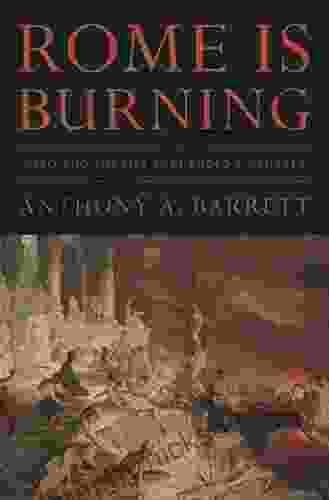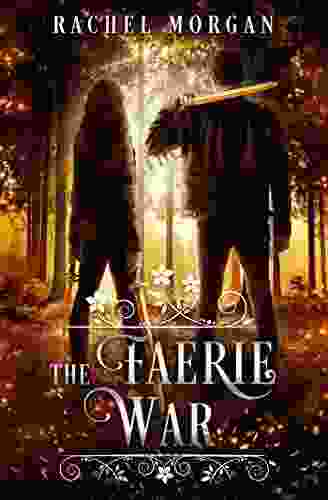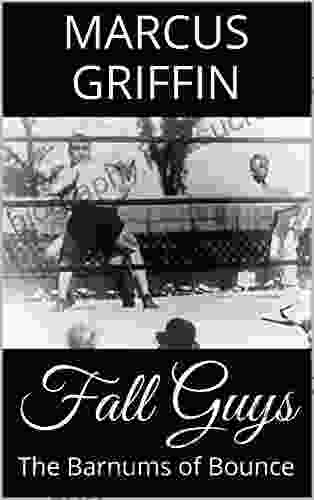Nero and the Fire that Ended a Dynasty: A Turning Point in Ancient History

In the annals of ancient history, few events have left as lasting and enigmatic a mark as the Great Fire of Rome in 64 AD. This catastrophic blaze, which consumed much of the city and left countless dead, forever altered the course of the Roman Empire. And at the heart of the fire's origins lies one of the most enduring mysteries of the ancient world: was Emperor Nero responsible?
For centuries, Nero has been accused of starting the fire, either as a way to clear land for his grand building projects or simply out of sheer madness. However, recent archaeological evidence has cast doubt on this long-held theory. In fact, it is now believed that the fire was more likely an accident, sparked by a faulty electrical system or a careless servant.
4.1 out of 5
| Language | : | English |
| File size | : | 33558 KB |
| Text-to-Speech | : | Enabled |
| Screen Reader | : | Supported |
| Enhanced typesetting | : | Enabled |
| Word Wise | : | Enabled |
| Print length | : | 358 pages |
The Great Fire of Rome
The Great Fire of Rome began on the night of July 19, 64 AD, in the Circus Maximus, a vast chariot racing stadium located in the heart of the city. The fire quickly spread, fanned by strong winds, and soon engulfed the entire Circus Maximus. From there, it spread to the surrounding neighborhoods, consuming everything in its path.
The fire raged for six days and seven nights, destroying over two-thirds of Rome. It reduced to ashes some of the city's most iconic landmarks, including the Temple of Jupiter Optimus Maximus, the Roman Forum, and the Circus Maximus itself. An estimated 100,000 people were left homeless, and thousands more were killed.
Nero's Response
In the aftermath of the fire, Nero responded swiftly. He ordered the immediate construction of new housing for the homeless and provided food and supplies to those who had lost everything. He also commissioned the building of a new aqueduct to improve the city's water supply and reduce the risk of future fires.
However, Nero's actions did little to quell the growing rumors that he had started the fire himself. These rumors were fueled by the emperor's own behavior. In the days following the fire, Nero was seen playing his lyre and singing while Rome burned. He also allegedly used the fire as an excuse to seize land from wealthy citizens and build his own opulent palace, the Domus Aurea.
Theories about Nero's Involvement
There are a number of theories about why Nero may have started the fire. Some historians believe that he wanted to clear land for his building projects. Others believe that he was motivated by a desire for revenge against the Roman people, who had recently rioted against his rule.
However, there is no concrete evidence to support any of these theories. In fact, the most likely explanation for the fire is that it was an accident. A faulty electrical system or a careless servant could have easily sparked the blaze, which then spread rapidly due to the strong winds and the city's dense wooden construction.
The Aftermath of the Fire
The Great Fire of Rome had a profound impact on the Roman Empire. It led to the construction of new buildings and infrastructure, and it also prompted Nero to implement a number of reforms, including the creation of a new fire department.
However, the fire also had a negative impact on the empire. It weakened Rome's economy and damaged its reputation. It also led to increased political instability and contributed to the decline of the Roman Empire.
The Great Fire of Rome was a pivotal event in ancient history. It forever altered the course of the Roman Empire and left a lasting legacy that is still felt today. While the fire's origins may never be fully known, it is clear that it was a turning point in Roman history.
4.1 out of 5
| Language | : | English |
| File size | : | 33558 KB |
| Text-to-Speech | : | Enabled |
| Screen Reader | : | Supported |
| Enhanced typesetting | : | Enabled |
| Word Wise | : | Enabled |
| Print length | : | 358 pages |
Do you want to contribute by writing guest posts on this blog?
Please contact us and send us a resume of previous articles that you have written.
 Fiction
Fiction Non Fiction
Non Fiction Romance
Romance Mystery
Mystery Thriller
Thriller SciFi
SciFi Fantasy
Fantasy Horror
Horror Biography
Biography Selfhelp
Selfhelp Business
Business History
History Classics
Classics Poetry
Poetry Childrens
Childrens Young Adult
Young Adult Educational
Educational Cooking
Cooking Travel
Travel Lifestyle
Lifestyle Spirituality
Spirituality Health
Health Fitness
Fitness Technology
Technology Science
Science Arts
Arts Crafts
Crafts DIY
DIY Gardening
Gardening Petcare
Petcare Richard H Immerman
Richard H Immerman Violet Moller
Violet Moller Barbara Illowsk
Barbara Illowsk Graham R Gibbs
Graham R Gibbs David A Bogart
David A Bogart Malcolm Hebron
Malcolm Hebron Jonathan Bergmann
Jonathan Bergmann Craig Lambert
Craig Lambert Betty Stone
Betty Stone Steve Burrows
Steve Burrows John Henry Phillips
John Henry Phillips Sergei Urban
Sergei Urban Clifford Herriot
Clifford Herriot Kit Yates
Kit Yates Charles Soule
Charles Soule Leia Stone
Leia Stone Shmuel Peerless
Shmuel Peerless Rob Hutchings
Rob Hutchings Leah Cullis
Leah Cullis Kathleen Masters
Kathleen Masters Yang Kuang
Yang Kuang Diane Cardwell
Diane Cardwell Jeff Belanger
Jeff Belanger Jessica Smartt
Jessica Smartt Emily Chappell
Emily Chappell Richard J Dewhurst
Richard J Dewhurst Richard Meadows
Richard Meadows Anthony Edwards
Anthony Edwards Bb
Bb Lynn Rosen
Lynn Rosen Grey Owl
Grey Owl Arny Alberts
Arny Alberts Thomas Lumley
Thomas Lumley Melissa Gomes
Melissa Gomes Margaret Owen
Margaret Owen Diane Yancey
Diane Yancey Jim Wharton
Jim Wharton Rachel Smith
Rachel Smith Bagele Chilisa
Bagele Chilisa Jonathan Kellerman
Jonathan Kellerman Robin Nixon
Robin Nixon Richard Chun
Richard Chun Burt L Standish
Burt L Standish Charles Buist
Charles Buist Pearson Education
Pearson Education Edwin R Sherman
Edwin R Sherman Holger Schutkowski
Holger Schutkowski Carlo Collodi
Carlo Collodi Eddie Merrins
Eddie Merrins Michael Wood
Michael Wood Cara Koscinski
Cara Koscinski Visual Arts
Visual Arts Harvey Wittenberg
Harvey Wittenberg Sam Kean
Sam Kean Jennifer Estep
Jennifer Estep Sharon Dukett
Sharon Dukett Cheryl Erwin
Cheryl Erwin Brad Burns
Brad Burns Scott Mactavish
Scott Mactavish Michelle Rigler
Michelle Rigler Barbara Ann Kipfer
Barbara Ann Kipfer Fred Mitchell
Fred Mitchell Joanna Hunt
Joanna Hunt John Aldridge
John Aldridge Suzanne Leonhard
Suzanne Leonhard Nadine Hays Pisani
Nadine Hays Pisani Kara Tippetts
Kara Tippetts Matt Taddy
Matt Taddy Barbara Bassot
Barbara Bassot Catherine M Cameron
Catherine M Cameron Trish Kuffner
Trish Kuffner Tori Day
Tori Day Robert Ardrey
Robert Ardrey Jane Butel
Jane Butel Catherine Shainberg
Catherine Shainberg Elizabeth George Speare
Elizabeth George Speare T H White
T H White S E Hinton
S E Hinton Charles River Editors
Charles River Editors James Duthie
James Duthie Christopher L Heuertz
Christopher L Heuertz Benita Bensch
Benita Bensch Eric Leiser
Eric Leiser Charlotte Booth
Charlotte Booth Kate Williams
Kate Williams Mick Conefrey
Mick Conefrey Arnold G Nelson
Arnold G Nelson Michael Palin
Michael Palin Percy Boomer
Percy Boomer Richard Harris
Richard Harris Chiara Sparks
Chiara Sparks Yuval Noah Harari
Yuval Noah Harari Richard Scott
Richard Scott John Kimantas
John Kimantas Joseph Epes Brown
Joseph Epes Brown Eric Franklin
Eric Franklin Nicholas Sparks
Nicholas Sparks Ascencia
Ascencia Constanze Niedermaier
Constanze Niedermaier Smart Reads
Smart Reads Eric Engle
Eric Engle John G Robertson
John G Robertson Pavla Kesslerova
Pavla Kesslerova David Taylor
David Taylor Deanna Roy
Deanna Roy Jayanti Tambe
Jayanti Tambe Joshua Hammer
Joshua Hammer Daniel P Huerta
Daniel P Huerta Stefan Ecks
Stefan Ecks Meghan L Marsac
Meghan L Marsac Reprint Edition Kindle Edition
Reprint Edition Kindle Edition Monica Hesse
Monica Hesse Conor Nolan
Conor Nolan John Quick
John Quick Jen Houcek
Jen Houcek Barbara Taylor
Barbara Taylor Lewis Thomas
Lewis Thomas Brian Gilbert
Brian Gilbert Robert Hogan
Robert Hogan Barry Burd
Barry Burd Reelav Patel
Reelav Patel Edward Lee
Edward Lee Vincent Bossley
Vincent Bossley Jenny Chandler
Jenny Chandler William H Frey
William H Frey Becca Anderson
Becca Anderson Victor Seow
Victor Seow Ian Leslie
Ian Leslie Rachelle Zukerman
Rachelle Zukerman John H Mcwhorter
John H Mcwhorter Leslie Stager
Leslie Stager Susan Scott
Susan Scott Steven Bell
Steven Bell John Sandford
John Sandford R L Medina
R L Medina Breanna Hayse
Breanna Hayse Ryan Higa
Ryan Higa James Koeper
James Koeper Allan V Horwitz
Allan V Horwitz Gerald Beaudry
Gerald Beaudry Donald R Gallo
Donald R Gallo Bryan Peterson
Bryan Peterson Dave Karczynski
Dave Karczynski Clayton King
Clayton King Thomas French
Thomas French Barbara Russell
Barbara Russell Geert Hofstede
Geert Hofstede Jade Barrett
Jade Barrett Peter K Tyson
Peter K Tyson Timothy Pakron
Timothy Pakron Chris Bennett
Chris Bennett James Duggan
James Duggan Nick Bollettieri
Nick Bollettieri S K Gupta
S K Gupta John C Norcross
John C Norcross David Aretha
David Aretha Janis Keyser
Janis Keyser Sam Cowen
Sam Cowen Mia Scotland
Mia Scotland Sam Harris
Sam Harris Max Marchi
Max Marchi Chris Cage
Chris Cage Jamie Margolin
Jamie Margolin Robin Mcmillan
Robin Mcmillan David Burch
David Burch Ron Lemaster
Ron Lemaster Charlie Shamp
Charlie Shamp P J Agness
P J Agness David Abram
David Abram Ray Comfort
Ray Comfort Jay Abramson
Jay Abramson James Randi
James Randi Yuki Mano
Yuki Mano Simon Spurrier
Simon Spurrier Steve Biddulph
Steve Biddulph Casey Watson
Casey Watson Fabien Clavel
Fabien Clavel Barbara Neiman
Barbara Neiman Gabriyell Sarom
Gabriyell Sarom James M Collins
James M Collins Beau Bradbury
Beau Bradbury Christine Kenneally
Christine Kenneally Dan R Lynch
Dan R Lynch Colleen Alexander Roberts
Colleen Alexander Roberts Blair Braverman
Blair Braverman Nichole Carpenter
Nichole Carpenter Graham Farmelo
Graham Farmelo Leon Mccarron
Leon Mccarron Kenneth Wilgus Phd
Kenneth Wilgus Phd Jessica F Shumway
Jessica F Shumway Pat Shipman
Pat Shipman David Jamieson Bolder
David Jamieson Bolder Karen Bush
Karen Bush Randy Baker
Randy Baker William Wasserman
William Wasserman Denton Salle
Denton Salle Hongyu Guo
Hongyu Guo Kara Goucher
Kara Goucher Mike Commito
Mike Commito Christopher Taylor Ma Lmft
Christopher Taylor Ma Lmft Linda Carroll
Linda Carroll Rachel Dash
Rachel Dash Maha Alkurdi
Maha Alkurdi Suzanne Wylde
Suzanne Wylde Dan Golding
Dan Golding Sean Mcindoe
Sean Mcindoe Noah Brown
Noah Brown Mitch Prinstein
Mitch Prinstein Tami Anastasia
Tami Anastasia Julian I Graubart
Julian I Graubart Gordon H Chang
Gordon H Chang Chadd Vanzanten
Chadd Vanzanten Molly E Lee
Molly E Lee Jutta Schickore
Jutta Schickore Jesse Liberty
Jesse Liberty Siddhartha Rao
Siddhartha Rao Tim Marshall
Tim Marshall Chuck Missler
Chuck Missler J Michael Veron
J Michael Veron J C Cervantes
J C Cervantes W Scott Elliot
W Scott Elliot Larry Dane Brimner
Larry Dane Brimner Massimo Cossu Nicola Pirina
Massimo Cossu Nicola Pirina Catherine J Allen
Catherine J Allen Toby A H Wilkinson
Toby A H Wilkinson Susan Dennard
Susan Dennard Patrick Sweeney
Patrick Sweeney Beau Miles
Beau Miles Mark Young
Mark Young Ronald Wheeler
Ronald Wheeler Cary J Griffith
Cary J Griffith Marc Loy
Marc Loy Erica B Marcus
Erica B Marcus Ping Li
Ping Li James Kilgo
James Kilgo Gary Lincoff
Gary Lincoff Muhammad Zulqarnain
Muhammad Zulqarnain Dr Michael P Masters
Dr Michael P Masters Vanessa Garbin
Vanessa Garbin Donald Frias
Donald Frias Candice Davie
Candice Davie Dave Rearwin
Dave Rearwin Bashir Hosseini Jafari
Bashir Hosseini Jafari Dustin Hansen
Dustin Hansen Danny Staple
Danny Staple Spencer Wells
Spencer Wells Oliver T Spedding
Oliver T Spedding Sampson Davis
Sampson Davis Mark Kurlansky
Mark Kurlansky Basudeb Bhatta
Basudeb Bhatta Linnea Dunne
Linnea Dunne Jean Smith
Jean Smith Emma Walker
Emma Walker Isabel Fonseca
Isabel Fonseca Jean Illsley Clarke
Jean Illsley Clarke Print Replica Kindle Edition
Print Replica Kindle Edition Julie L Spencer
Julie L Spencer Rick Joyner
Rick Joyner Barbara Mertz
Barbara Mertz Macauley Lord
Macauley Lord Jeff Alt
Jeff Alt Shayla Black
Shayla Black Laura Ingalls Wilder
Laura Ingalls Wilder Mike Stanton
Mike Stanton Autumn Carpenter
Autumn Carpenter Titus M Kennedy
Titus M Kennedy Kindle Edition
Kindle Edition Stephanie Fritz
Stephanie Fritz Nicole Martin
Nicole Martin Buddy Levy
Buddy Levy Tim Ingold
Tim Ingold C R Hallpike
C R Hallpike Craig Romano
Craig Romano Mike Loades
Mike Loades Barry J Kemp
Barry J Kemp Jane Hardwicke Collings
Jane Hardwicke Collings Otto Scharmer
Otto Scharmer Kam Knight
Kam Knight Kyle Butler
Kyle Butler Mike High
Mike High Bill Milliken
Bill Milliken Cynthia Levinson
Cynthia Levinson Daniel T Willingham
Daniel T Willingham Kate Darling
Kate Darling Rowan Jacobsen
Rowan Jacobsen Rob Rains
Rob Rains Marco Grandis
Marco Grandis Mark H Newman
Mark H Newman George Macdonald
George Macdonald Tara Brach
Tara Brach Jill Brown
Jill Brown Mark Ellyatt
Mark Ellyatt Master Gamer
Master Gamer Barry Rabkin
Barry Rabkin Barry Johnston
Barry Johnston Ryan T White
Ryan T White Janna Levin
Janna Levin Barbara Kennard
Barbara Kennard Barry Rhodes
Barry Rhodes Ellen Lewin
Ellen Lewin John D Barrow
John D Barrow Stephen K Sanderson
Stephen K Sanderson Temple West
Temple West Tom Miller
Tom Miller Debbie M Schell
Debbie M Schell Joanne Glenn
Joanne Glenn Elliott Vandruff
Elliott Vandruff Bob Holtzman
Bob Holtzman Susan Nance
Susan Nance Jim Fay
Jim Fay Julie Buxbaum
Julie Buxbaum Nick Neely
Nick Neely Mike Allison
Mike Allison Glenna Mageau
Glenna Mageau David Thomas
David Thomas Richard Weissbourd
Richard Weissbourd Steven Rinella
Steven Rinella Sara Shepard
Sara Shepard Jenn Mcallister
Jenn Mcallister Crystal Duffy
Crystal Duffy Chris Eberhart
Chris Eberhart Bernard Marr
Bernard Marr Samantha Fitts
Samantha Fitts Editors Of Southern Living Magazine
Editors Of Southern Living Magazine Sam Nadler
Sam Nadler Cait Stevenson
Cait Stevenson Nina Manning
Nina Manning Proper Education Group
Proper Education Group Gary Soto
Gary Soto Ernie Morton
Ernie Morton Roanne Van Voorst
Roanne Van Voorst Stan Tekiela
Stan Tekiela Sport Hour
Sport Hour Diane Musho Hamilton
Diane Musho Hamilton Lock Gareth
Lock Gareth Barry Friedman
Barry Friedman F William Lawvere
F William Lawvere Laura Pavlov
Laura Pavlov Justin Sirois
Justin Sirois Rhonda Belle
Rhonda Belle William Byers
William Byers Ben Povlow
Ben Povlow Marshall Jon Fisher
Marshall Jon Fisher Helen Kara
Helen Kara Stephen J Bavolek
Stephen J Bavolek Valerie Pollmann R
Valerie Pollmann R Nancy E Willard
Nancy E Willard Mike Swedenberg
Mike Swedenberg Geoffrey Finch
Geoffrey Finch Paul Doiron
Paul Doiron Paul Van Lierop
Paul Van Lierop Ben Collins
Ben Collins Scarlett Thomas
Scarlett Thomas Dacher Keltner
Dacher Keltner Kenton Kroker
Kenton Kroker W Hamilton Gibson
W Hamilton Gibson Eugene V Resnick
Eugene V Resnick John Whitman
John Whitman Ellen Notbohm
Ellen Notbohm Jeffrey Jensen Arnett
Jeffrey Jensen Arnett Philip Maffetone
Philip Maffetone Wanda Priday
Wanda Priday John Lister Kaye
John Lister Kaye David Cockburn
David Cockburn James Syhabout
James Syhabout Peter Martin
Peter Martin Craig Martin
Craig Martin Dustin Salomon
Dustin Salomon Robin Knox Johnston
Robin Knox Johnston Emma Brockes
Emma Brockes Shannon Reilly
Shannon Reilly Daniel S Lobel Phd
Daniel S Lobel Phd Martin Sternstein
Martin Sternstein Martin Dugard
Martin Dugard Lynn Mann
Lynn Mann Farley Mowat
Farley Mowat Ben Goldacre
Ben Goldacre Charlotte Browne
Charlotte Browne Baruch Englard
Baruch Englard Rebecca Solnit
Rebecca Solnit Mackenzi Lee
Mackenzi Lee Rob Pope
Rob Pope Ralph Galeano
Ralph Galeano Jennifer Traig
Jennifer Traig Roy Porter
Roy Porter Wayne B Chandler
Wayne B Chandler Stanislas Dehaene
Stanislas Dehaene Jennifer Pharr Davis
Jennifer Pharr Davis Scott Reed
Scott Reed Mary A Fristad
Mary A Fristad Jake Anderson
Jake Anderson Scott Westerfeld
Scott Westerfeld Eliza Reid
Eliza Reid Erica Schultz
Erica Schultz Melissa Haag
Melissa Haag Mark Rashid
Mark Rashid James C Radcliffe
James C Radcliffe Guy P Harrison
Guy P Harrison Jenna Helland
Jenna Helland Beth Miller
Beth Miller Joseph Alton M D
Joseph Alton M D Peter Wacht
Peter Wacht Brandon Royal
Brandon Royal Marie Rutkoski
Marie Rutkoski Nicholas Wolterstorff
Nicholas Wolterstorff Achille Rubini
Achille Rubini Prince Asare
Prince Asare Gordon Witteveen
Gordon Witteveen Lily Collins
Lily Collins J Bruce Brackenridge
J Bruce Brackenridge Alexandra Andrews
Alexandra Andrews Dr Faith G Harper
Dr Faith G Harper Bruce Pascoe
Bruce Pascoe Scott Malthouse
Scott Malthouse T C Edge
T C Edge Chase Hill
Chase Hill Frederick Douglass Opie
Frederick Douglass Opie Mina Lebitz
Mina Lebitz Ryan A Pedigo
Ryan A Pedigo Bobbie Faulkner
Bobbie Faulkner Barbara Rogoff
Barbara Rogoff Basu Shanker
Basu Shanker Ken Xiao
Ken Xiao Brian Switek
Brian Switek David Klausmeyer
David Klausmeyer John Garrity
John Garrity St Louis Post Dispatch
St Louis Post Dispatch Debra Kilby
Debra Kilby Joseph Schmuller
Joseph Schmuller Dr Craig Malkin
Dr Craig Malkin Boy Scouts Of America
Boy Scouts Of America Monta Z Briant
Monta Z Briant Elizabeth Lockwood
Elizabeth Lockwood Beebe Bahrami
Beebe Bahrami Steven Hawthorne
Steven Hawthorne Vanessa Ogden Moss
Vanessa Ogden Moss Rebecca Rupp
Rebecca Rupp Bill Mckibben
Bill Mckibben Ben Sedley
Ben Sedley V B Alekseev
V B Alekseev Khurshed Batliwala
Khurshed Batliwala Leonard M Adkins
Leonard M Adkins Gay Robins
Gay Robins David Starbuck Smith
David Starbuck Smith Linda Welters
Linda Welters Hunbatz Men
Hunbatz Men Luke Gilkerson
Luke Gilkerson Nick Townsend
Nick Townsend Erik J Brown
Erik J Brown Bridget Flynn Walker Phd
Bridget Flynn Walker Phd Mark Twain
Mark Twain Thomas Bulfinch
Thomas Bulfinch Lew Freedman
Lew Freedman Ron Avery
Ron Avery Chris Mooney
Chris Mooney Farzana Nayani
Farzana Nayani Bonnie Tsui
Bonnie Tsui Daniel M Koretz
Daniel M Koretz Jude Currivan
Jude Currivan Hollis Lance Liebman
Hollis Lance Liebman Robert A Baruch Bush
Robert A Baruch Bush Mark Mayfield
Mark Mayfield Jack Newman
Jack Newman Babu The Panda
Babu The Panda Mykel Hawke
Mykel Hawke Cindy Post Senning
Cindy Post Senning David Beaupre
David Beaupre Edith Grossman
Edith Grossman Joshua G Shifrin
Joshua G Shifrin John J Robinson
John J Robinson Barbara Gastel
Barbara Gastel Hill Gates
Hill Gates Helen Fisher
Helen Fisher Lawrence Baldassaro
Lawrence Baldassaro Barry Glassner
Barry Glassner Jaymin Eve
Jaymin Eve Daniel J Barrett
Daniel J Barrett Barzin Pakandam
Barzin Pakandam Jack Andraka
Jack Andraka Mike Massie
Mike Massie Jeremy Sweet
Jeremy Sweet Rachel Morgan
Rachel Morgan Alastair Hannay
Alastair Hannay Howard Zinn
Howard Zinn
Light bulbAdvertise smarter! Our strategic ad space ensures maximum exposure. Reserve your spot today!

 Italo CalvinoMy Very Vegetarian Pregnancy Recipes for Months and Beyond: A Comprehensive...
Italo CalvinoMy Very Vegetarian Pregnancy Recipes for Months and Beyond: A Comprehensive...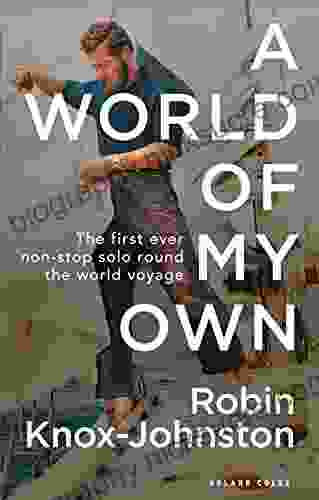
 Marvin HayesThe First Ever Non-Stop Solo Round-the-World Voyage: A Monumental Achievement...
Marvin HayesThe First Ever Non-Stop Solo Round-the-World Voyage: A Monumental Achievement...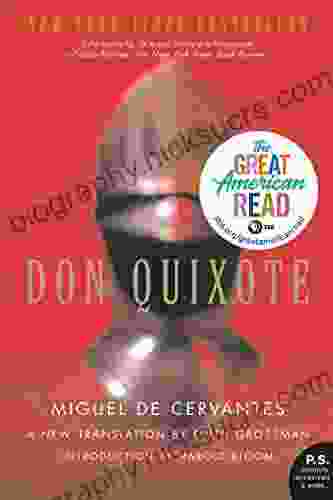
 Chinua AchebeUnlocking the Enchanting World of Don Quixote: Edith Grossman's Masterful...
Chinua AchebeUnlocking the Enchanting World of Don Quixote: Edith Grossman's Masterful... Dan HendersonFollow ·10.4k
Dan HendersonFollow ·10.4k Corey HayesFollow ·11.3k
Corey HayesFollow ·11.3k John GrishamFollow ·7.8k
John GrishamFollow ·7.8k Julio Ramón RibeyroFollow ·9.3k
Julio Ramón RibeyroFollow ·9.3k Camden MitchellFollow ·16.7k
Camden MitchellFollow ·16.7k William WordsworthFollow ·16.1k
William WordsworthFollow ·16.1k Eddie BellFollow ·16.9k
Eddie BellFollow ·16.9k James JoyceFollow ·12.4k
James JoyceFollow ·12.4k

 Israel Bell
Israel BellEmbark on an Epic 160-Mile Expedition for Charity on the...
Prepare yourself for an...
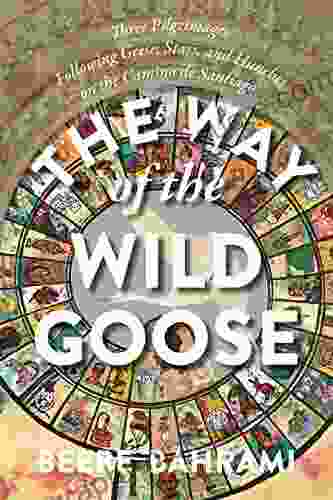
 Josh Carter
Josh CarterThe Way of the Wild Goose: A Journey of Embodied Wisdom...
The Way of the Wild Goose is an ancient...

 Allen Parker
Allen ParkerMastering the Art of Bean Fly Casting: A Comprehensive...
Fly fishing,...
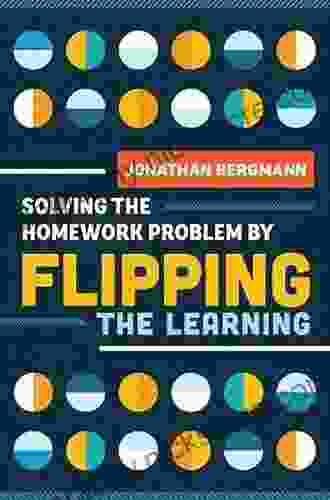
 Aaron Brooks
Aaron BrooksSolving the Homework Problem by Flipping the Learning
What is flipped...

 Fletcher Mitchell
Fletcher MitchellThe Jane Butel Library: A Renewed Source of Knowledge and...
The Jane Butel...
4.1 out of 5
| Language | : | English |
| File size | : | 33558 KB |
| Text-to-Speech | : | Enabled |
| Screen Reader | : | Supported |
| Enhanced typesetting | : | Enabled |
| Word Wise | : | Enabled |
| Print length | : | 358 pages |


